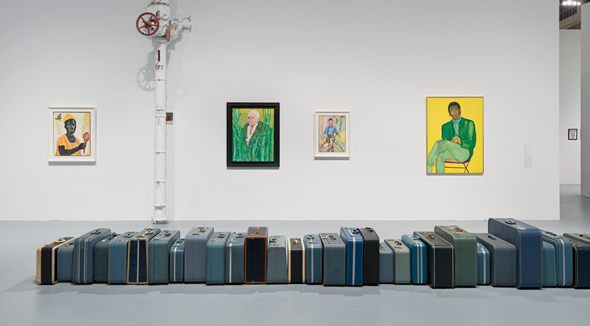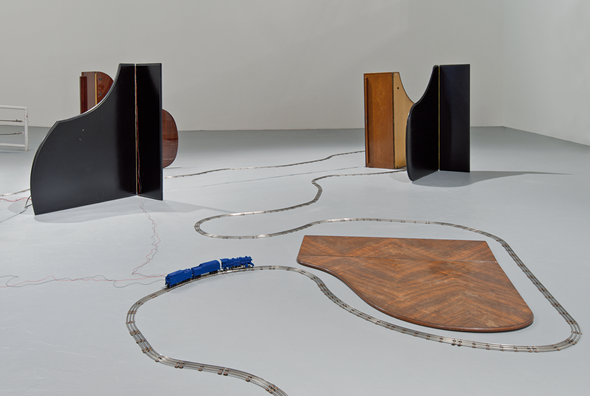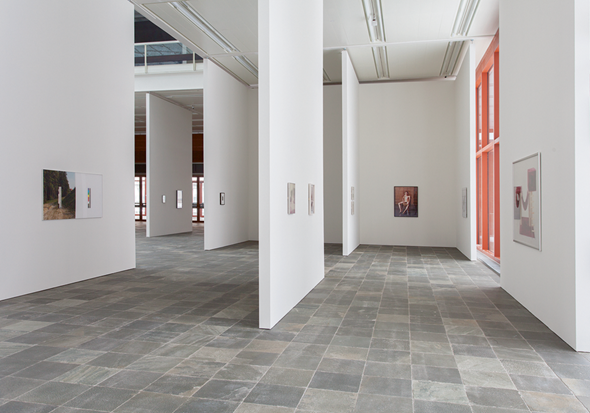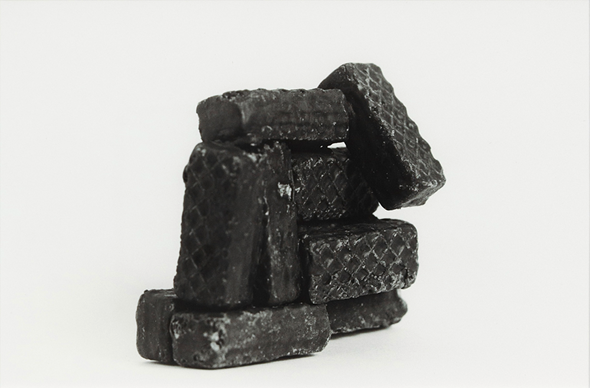»Blues for Smoke«
MOCA, Los Angeles 21.10.2012–7.1.2013
Whitney Museum, New York 7.2.–28.4.2013

Installation view »Blues for Smoke« The Geffen Contermporary at MOCA. Photo: Brian Forrest
A Sweet, Sweet Ache
Six years in the making, curator Bennett Simpson’s inspired and surprising exhibition Blues for Smoke takes its title from the 1960 Jaki Byard jazz piano album of that name. Filling the expanse of MOCA’s Geffen Contemporary in its first incarnation, Blues For Smoke is neither a show about the blues, nor a show about American history. Rather, it’s an evocation of an attitude that Simpson locates in a variety of works by artists as diverse as mid-century Harlem photographer Roy DeCarava, Jutta Koether, Romare Bearden, Charles Gaines, Martin Kippenberger, Henry Taylor, Zoe Leonard and Liz Larner. This sensibility is variously defined in texts associated with the exhibition as »an impulse to keep the painful details and episodes of a brutal experience alive in one’s aching consciousness, and … to transcend it … by squeezing from it a near-tragic, near-comic lyricism« (Ralph Ellison); or as »the condition of truth [that] allows suffering to speak« (Cornel West); or as a poetry that is made »with what I feel is useful and can be saved out of all the garbage of our lives«. (Amiri 140 Baraka writing as LeRoi Jones).
Blues For Smoke is, in my opinion, one of the most original and deeply felt exhibitions to be mounted at a major institution for a long time. Despite the momentum created by Thelma Golden’s game-changing 2001 Freestyle exhibition at the Studio Museum in Harlem, where she coined the term »post-black«, Simpson rightly identifies a persistent racial segregation that is so blatant and so obvious that it virtually preempts discussion. As he eloquently states in his introductory catalogue essay, This Air, the exhibition anticipates a time when »the invention and experiment of African American cultural traditions are not thought to languish on the side lots of what is modern, at the fringes of the perceived avant-garde, in the side-ways of critical discourse … but valued as central, exemplary, and real to experience «.

front Zoe Leonard, Blue Suitcases; back Beauford Delaney. Photo: Brian Forrest
Blues for Smoke is (like all of life) implicitly political, but the argument the exhibition most forcibly makes is that the aesthetic practices most valued in contemporary art critical discourse can be found in music and poetry created by African American artists more than half a century ago. When jazz saxophonist Jackie McLean described the promise of free jazz as »the big room«, was he not referring to a collective, intersubjective space? Likewise, the series of Mark Morrisroe photographs from New York in the late 70s and 80s demonstrate, to Simpson, a classic blues sensibility: the »desire for subversion, private pleasure, and getting by«.
CHRIS KRAUS

Installation view »Blues for Smoke« The Geffen Contermporary at MOCA. Photo: Brian Forrest
»Photos - Points of view in Austrian Photography from the 1930s until today«
21er Haus, Vienna 30.1.–5.5.2013

Silver gelatin print with metallic salt toner on silver base 48 x 37 cm © Artothek des Bundes


B/W photo on barite paper, 56 x 46 cm © Belvedere, Wien

In the foreground is singer Christa Ludwig, 1966 Digital print on barite paper (2012) © Belvedere, Vienna
